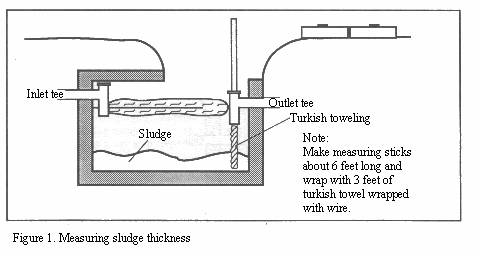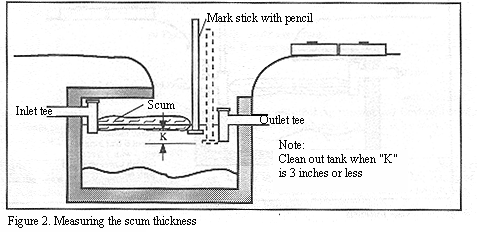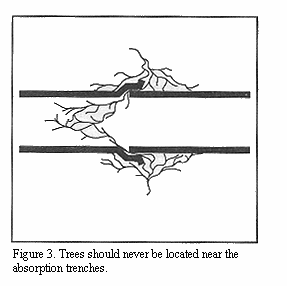Contrary to common belief, septic tanks
are not maintenance free. However, properly designed septic
tanks installed correctly and not overloaded with water or
household grease or solids from garbage disposals normally
function well for many years.
Typically, septic tanks are made of precast concrete. Some
tanks have lids of three or more parts. The baffles (or tees)
must be in good condition to keep floating scum and grease
from leaving the tank and plugging the soil in the drainfield.
In addition to the floating scum, the tanks also contain
liquid sewage, which eventually flows to the drainfield. Over
a period of time, a sludge layer forms in the bottom of the
tank. The sludge consists of the solids that remain after the
anaerobic bacteria in the tank breaks down the solid wastes.
The natural process of anaerobic digestion normally does
quite well on its own, so no chemicals, enzymes, yeast or
other additives should be routinely fed into the tanks. Normal
household chemicals and occasional use of drain cleaners will
not significantly affect tank operation. Roots that penetrate
porous drain lines can sometimes be controlled by adding
copper sulfate crystals.

Sludge eventually accumulates in the bottom of all septic
tanks. The buildup is slower in warm climates than in colder
climates. The only way to determine the sludge depth is to
measure the sludge with a probe inserted through an inspection
port in the tank's lid. Do not put this job off until the tank
and sewer fills and the toilet overflows. If this happens,
damage to the drainfield could occur and be expensive to
repair.
Once each year, measure the sludge depth with a probe. To
measure the sludge depth, wrap a long stick with a piece of
rough white toweling (secured with wire, using pliers) on one
end. Slowly lower the towel-wrapped end of the stick through
the large inspection port or through the outlet tee (to avoid
the scum) to the bottom of the tank. After a few minutes,
remove the probe slowly. Black sludge particles cling to the
towel and indicate the sludge level in the tank. If the sludge
layer is within three to four inches of the submerged outlet
tee, the tank should be cleaned. Many warm-climate septic
tanks that are lightly loaded can serve 20 years or more
before cleaning. Nevertheless, tanks should be monitored
periodically to prevent sludge buildup and damage to the
drainfield caused by plugging of the soil.

The floating scum thickness can be measured with a probe.
The scum thickness and the vertical distance from the bottom
of the scum to the bottom of the inlet tee can also be
measured. If the bottom of the scum gets within three inches
of the outlet tee, scum and grease can enter the drainfield.
If grease gets into the drainfield, percolation is impaired
and the drainfield can fail. If the scum is near the bottom of
the tee, the septic tank needs to be cleaned out. The scum
thickness can best be measured through the large inspection
port as shown.
Tree roots can
enter sewage and drainfield lines and cause plugging of the
lines. Lines should not be placed near trees, and trees should
not be planted near lines. Remove tree roots mechanically or
flush copper sulfate crystals down the toilet to help
discourage or destroy the roots where the solution comes in
contact with them. Some time must elapse before the roots are
killed and broken off. Recommended dosage rates are two pounds
per 300 gallons of tank capacity. No more than two
applications per year are recommended. Time the application of
copper sulfate to allow minimum dilution and maximum contact
time. Copper sulfate will corrode chrome, iron and brass, so
avoid contact with these materials. Used in recommended
dosage, copper sulfate will not interfere with septic tank
operation. Neither mechanical removal nor copper sulfate
contact is a permanent solution for tree roots. Remove the
trees for a permanent solution to the problem.

Damage
to the septic tank and drainfield can occur from traffic or
wheel loads on the system. No vehicles should be driven over
septic tank systems. No driveways, concrete surfaces or
asphalt should be placed over drainfield lines or the septic
tank. If vehicles must cross the drainfield, use cast iron
pipe or heavy pipe under the crossing.
It is
sometimes easy to tell when the drainfield is not working
properly. Failure occurs when the soil is not adequately
absorbing the effluent and it comes to the surface as a
result. Growth of lush and dark green grass may indicate the
point of failure. A black-gray odorous liquid may be seen at
the soil surface when failure occurs. If liquid rises to the
surface, a health hazard could exist for children, who should
be kept away from the area until the problem is solved.
A number of problems can cause failure, including solids
filling the septic tank, tree roots, excessive grease from the
kitchen, overloading and excessive water. Leaking plumbing
fixtures should be repaired immediately, because a continuous
leak can saturate the drainfield and cause failure of the
system. Water-saving shower heads and plumbing fixtures and
other water conservation measures are beneficial. It is a good
idea to direct surface water away from drainfields to allow
more absorption from the tank. It may become necessary to add
a waste pump to pump the effluent to an alternate drainfield
in another site.
If through misuse or neglect the drainfield becomes
clogged, it may be desirable to install additional drain tile.
Some advantages exist in alternating the use of drainfields if
a second drainfield can be added. If flow is diverted to
another field and the ailing field is rested, the biological
substances causing the soil to clog will break down over a
period of time. A diversion valve can be used to control flow
to the newly constructed field. Allowing six to 12 months of
rest for the failing field often allows the biological
breakdown of the substances plugging the soil.
Other methods to remedy failing drainfields have been
tried. One method is to flush the drainfield with hydrogen
peroxide. Studies at the University of Wisconsin show only a
partial cure with highly variable results even in sandy soils.
Any use of chemicals (such a hydrogen peroxide) should be
carried out only by a professional who has experience and can
perform the procedure safely. Another method is pressure
dosing. Dosing involves flooding the drainfield two or three
times a day with large volumes of water. Uniform distribution
of the effluent is assured, so the entire field is flooded and
the soil gets a short rest between applications. The theory
behind dosing involves exposing the entire infiltrating
surface to air to improve biodegrading and reduce soil
clogging. The practice should be considered marginally
successful at best.
- Preventative maintenance is the best approach for septic
tanks. Preventative measures include:
- Monitoring sludge and scum levels in the septic tank on
an annual basis.
- Minimizing grease, solids from garbage disposals,
chemicals and other materials. Discharge from grease traps
cannot go to the drainfield unless it goes through the
septic tank.
- Reducing water flow into sewers and never emptying water
from downspouts into the septic tank. Direct surface water
away from the drainfield.
- Planting grass over the septic tank and drainfield to
reduce erosion and to absorb moisture and nutrients.
- Avoiding traffic or wheel loads over the septic tank and
drainfield. Don't put driveways over drainfields or tanks.
- Removing trees from the drainfield area to avoid tree
root problems.
- Getting help when you suspect a problem, to minimize the
damage.
- Checking with your local health department before
purchasing a lot for home construction if you plan to
install a septic tank. This cannot be overemphasized.
Any person who
cleans or removes the contents of septic tanks must obtain a
septage removal permit, which is renewed annually. Application
for permits must be submitted in writing at least 10 days
before the cleaning will be done. Disposal and removal methods
must be defined. If land application or subsurface land
disposal is used, additional information may be required.
The acceptable method of disposal of septage includes
processing septage through a wastewater treatment plant, or
septage handling facility, or land application. Disposal by
any of these methods may require written permission from the
appropriate government agency, the local health department and
land owner.
Septic tanks
require reasonable usage and maintenance to ensure efficient
operation. The following suggestions should be followed:
- Repair leaking plumbing fixtures to avoid complete soil
saturation and premature tank failure. Add water-saving
fixtures and shower heads to reduce loading on the soil.
- Allow only household waste to be disposed into the
system. Put kitchen grease and garbage into the trash, not
in the septic tank.
- Septic tanks require periodic cleaning (pumping out) to
remove accumulated solids. Do not allow the septic tank to
fill with solids and overflow into the drainfield. If this
happens, the soil in the drainfield can become sealed (water
will not percolate into the soil) and is very expensive to
repair.
- The solid level in the tank should be monitored annually
and pumped out before overflow occurs. Unfortunately, most
homeowners will not do this. If checks are not made on
solids levels, the tank should be cleaned every five years
or so. It is difficult to predict how fast solids will build
up in the tanks because many factors are involved. When you
decide to pump out the septic tank, contact your local
health department for a list of approved contractors who are
permitted to handle this waste.
| 



